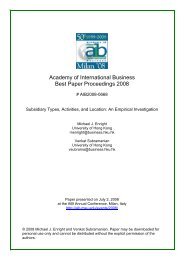AIB 2012 Conference Proceedings - Academy of International ...
AIB 2012 Conference Proceedings - Academy of International ...
AIB 2012 Conference Proceedings - Academy of International ...
You also want an ePaper? Increase the reach of your titles
YUMPU automatically turns print PDFs into web optimized ePapers that Google loves.
SUNDAY<br />
Shariah Governance in Islamic Financial Institutions: A Multi-Country Analysis<br />
Hussain G. Rammal, University <strong>of</strong> South Australia<br />
Lee D. Parker, University <strong>of</strong> South Australia<br />
Since its <strong>of</strong>ficial launch in the 1970's, Islamic financing has grown at a rapid rate. Today Islamic banks are<br />
operating in nearly all Muslim countries and many non-Muslim countries like India, Singapore, Thailand, United<br />
Kingdom and United States. Unlike conventional financing, Islamic financing prohibits the use <strong>of</strong> interest in<br />
commercial transactions. To ensure compliance <strong>of</strong> the religious requirements, Islamic financial institutions are<br />
required to utilise the services <strong>of</strong> Shariah (Islamic law) scholars. There has been limited research undertaken in<br />
the area <strong>of</strong> Shariah supervision in Islamic financing and this study makes a contribution by analysing the<br />
Shariah governance model followed by the Islamic financial institutions operating in Pakistan, and comparing it<br />
to other national models used in Bahrain, Indonesia, Iran and Malaysia. Using the New Institutional theory<br />
frame, the study reveals that there is a lack <strong>of</strong> consistency in the application <strong>of</strong> the governance model and the<br />
pre-existing structures that exist in each country has an impact on how the national models have evolved. The<br />
findings also show that there is evidence for mimetic and normative isomorphism in the sector which may lead<br />
to greater consistencies in Shariah application and governance in Islamic financial institutions across the<br />
countries in the future (For more information, please contact: Hussain G. Rammal, University <strong>of</strong> South Australia,<br />
Australia: hussain.rammal@unisa.edu.au)<br />
Session: 1.3.13 - Interactive<br />
Track: 6 - Innovation and Knowledge Mgmt.<br />
How to Enhance Innovation Performance<br />
Presented On: July 1, <strong>2012</strong> - 13:00-14:15<br />
Chair: John W Clarry, Rutgers University<br />
Impact <strong>of</strong> Global New Product Development Practice on Innovation Learning and Project Performance<br />
Jeen-Su Lim, University <strong>of</strong> Toledo<br />
John H. Heinrichs, Wayne State University<br />
With increased global competition and globalized market, firms are required to commit to not only product<br />
development but also globalization <strong>of</strong> innovation efforts to gain a competitive advantage in the turbulent<br />
competitive environment. This study develops and tests a conceptual model that captures the relationships<br />
among two global product development practices (globalized new product development team and global<br />
product design focus), two types <strong>of</strong> learning (individual learning and collective learning), and project<br />
performance. Managerial and theoretical implications are discussed. (For more information, please contact:<br />
Jeen-Su Lim, University <strong>of</strong> Toledo, USA: jlim@utnet.utoledo.edu)<br />
How Does Innovation Impact Firm Performance Direct v. Mediated Effects <strong>of</strong> Patent Scale and Scope<br />
Sonya H. Wen, Tamkang University<br />
Jennifer H. Chen, Nanhua University<br />
How does technological innovation impact the financial performance <strong>of</strong> technology-intensive firms From the<br />
knowledge-based view, we hypothesized and tested a firm performance model determined by patent scale and<br />
scope. For illustrating whether or not performance effects exist and how patent impacts performance, we<br />
analyzed the test-results on multiple subsamples <strong>of</strong> 106 Fabless firms in Taiwan, during 1995 and 2007. The t-<br />
test results on mean-differences <strong>of</strong> multiple performance indicators support our hypothesis that active<br />
innovators in terms <strong>of</strong> patent scale and patenting frequency perform better than passive innovators. Using the<br />
panel data <strong>of</strong> the full versus patenting subsamples, we further compared the lagging direct and mediated<br />
<strong>AIB</strong> <strong>2012</strong> <strong>Conference</strong> <strong>Proceedings</strong><br />
Page 49

















